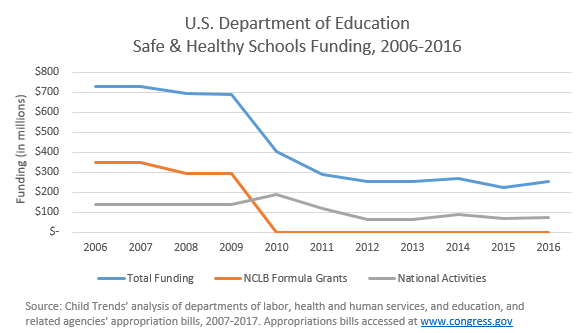This week will likely mark a turning point in our nation’s effort to provide all students with safe, supportive, and engaging spaces in which to learn. Assuming federal lawmakers pass a 2017 budget by the April 28 deadline, Congress will soon decide the funding levels for the new Student Support and Academic Enrichment (SSAE) program, authorized by Congress in 2015 under Title IV of the Every Student Succeeds Act (ESSA). The program is now the U.S. Department of Education’s (ED) primary method of helping states address the social, emotional, and behavioral needs, and mental and physical health, of their students.
While SSAE is a bit of a grab bag—it includes funding to support education technology and improve access to enriching coursework, in addition to student supports—it clearly demonstrates that our government recognizes the relationship between school conditions and student learning. Research shows that students who are suspended or expelled are more likely to drop out of school or be held back a grade. We also know that promoting students’ social and emotional skills can improve their academic achievement by as much as 11 percentile points. At the same time, in 2014, 14 percent of all students were chronically absent and 21 percent of high school students did not have access to a school counselor.
What’s more, each of these risks and assets varies widely by race and ethnicity, and by disability status.
Despite this knowledge, the last decade has seen significant decreases in federal support for programs dedicated to school safety and student supports. (Full disclosure #1: Child Trends receives federal funding to support communities in creating supportive school environments. Full disclosure #2: I worked in the U.S. Department of Education as these decreases were taking place.) Up until now, the bulk of federal financial support for student health and safety came from four related funding streams housed under Titles IV and V of No Child Left Behind:
- the Safe and Drug-Free Schools and Communities state formula program;
- National Activities programming, which supported innovative discretionary (read “competitive”) programs and technical assistance projects; and
- two discretionary programs dedicated to school counseling and physical education.
Over the last 10 years, federal investment in these programs decreased from a high of $730 million in 2006 to a low of $223 million in 2015.[1]
But there’s more to this story: fiscal year 2009 was the last year in which all states received support under the Safe and Drug-Free Schools and Communities formula program. From 2010 through 2016, the only funding for student health and safety available to states has come from discretionary grant programs. To be clear, these initiatives have funded innovations in school climate measurement (e.g., the 2010 Safe and Supportive Schools grant) and promoted evidence-based approaches (e.g., the 2013 School Climate Transformation Grant), among other local initiatives designed to push the field forward. However, these financial supports were not designed to serve children in all states.

That’s why this week represents a turning point. The new SSAE program would bring back formula dollars for every state. Under ESSA, Congress may appropriate up to $1.65 billion for the program this year, and $1.6 billion annually between 2018 and 2020.
This month, 10 states and the District of Columbia submitted their state plans to ED, including their methods for identifying schools in need of intervention. A number of states have included school climate measures in their proposed accountability systems: Connecticut, New Mexico, and Tennessee, for example, have included chronic absenteeism, while Connecticut has also included physical fitness and Tennessee is considering school discipline.
In these states and others, education officials are working to place school conditions and student supports alongside academic rigor as a strategy to promote educational equity and achievement. This week, we’ll find out if federal lawmakers will follow their example.
[1] Note that that this $223 million figure in 2015, and the $255 million figure in 2016, both include funding for the Promise Neighborhoods program. While appropriations bills categorize funding for Promise Neighborhoods amid the other safe schools programs, whether they should is debatable. The Promise Neighborhoods program, modeled on the Harlem Children’s Zone, was introduced in 2010 to address a range of issues facing students and communities, of which student supports is only a part. Congress appropriated $57 million for Promise Neighborhoods in 2015 and $73 million in 2016.
© Copyright 2025 ChildTrendsPrivacy Statement
Newsletter SignupLinkedInYouTubeBlueskyInstagram